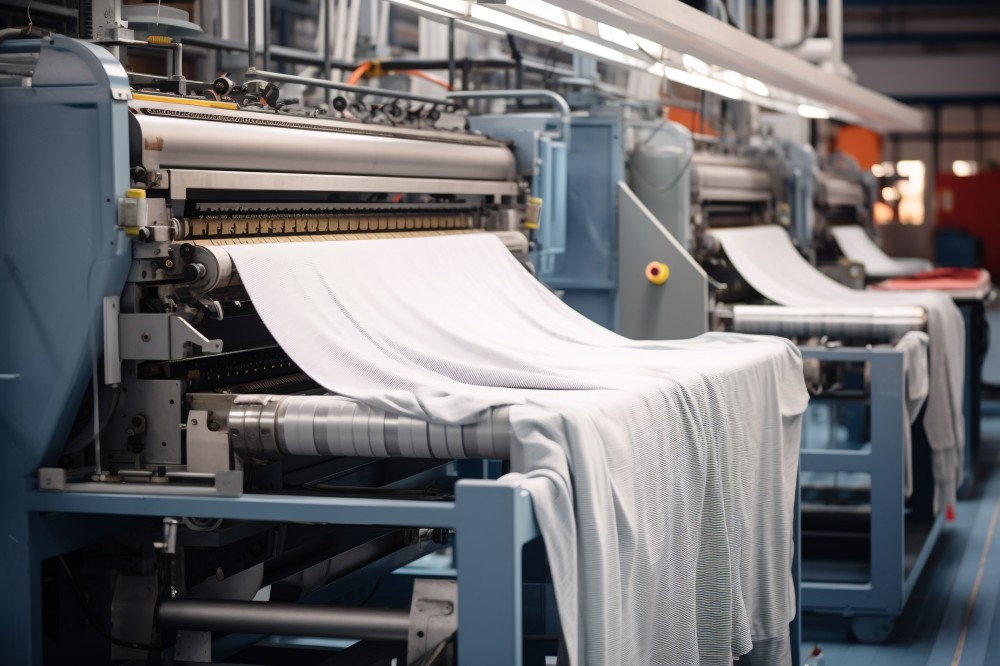Fabric Shrinkage Control Guide: Prevent 23% Quality Issues in Dyeing and Finishing Processes
Abstract
25-Year Dyeing & Finishing Expert's Proven Insight: Fabric width control system reduces textile defects by 23% and increases profit margins by 15%. This article delivers end-to-end textile production cost optimization strategies from fabric design to setting processes, including critical data on elastic fabric shrinkage control and high-twist fabric setting parameters.

Why Uncontrolled Fabric Width = Profit Erosion?
- Defect Costs: 23% of quality defects in dyeing and finishing processes stem from width deviation.
- Profit Impact: Uncontrolled width in single production lot causes direct profit losses of up to 15%.
- Case Study: Implementation of this solution on 600D jacquard fabric at domestic dyeing mill reduced width rebound from 4.8cm to 0.9cm.
I. Design Stage: 3 Key Points
1.1 Material Selection Reference Table
| Material Type | Shrinkage Rate Difference | Application Scenarios |
| 75D Polyester Filament | +18% | Regular Apparel Fabrics |
| 5% Spandex Elastic Fabric | +25% | Sportswear/Underwear/Activewear |
| 65/35 Polyester-Viscose Blend | -40% | Workwear/Home Textiles |
1.2 Weaving Parameters Quick Reference
Under identical processing conditions, plain weave and twill fabrics can exhibit width variation of up to 8 cm.
- Density Optimization
Warp/Weft Density: Every +10 ends/picks per inch → Finished product shrinkage rate +2.3%.
Optimal Solution: 2/1 twill weave structure → Width variation controlled within ±0.5cm
 Operational Tip:
Operational Tip:
Reserve 8-12% shrinkage allowance for high-stretch fabric
Ⅱ Hidden Risks in Fabric Preparation
graph TD
A[Grey Fabric Preparation] --> B{Elasticity Testing}
B -->|Contains Spandex| C[Dynamic Resting Protocol]
B -->|Conventional Fabric| D[Standard Resting]
C --> E[Humidity Monitoring + Scheduled Cloth Turning]
E --> F[Open Width Washing]
2.1 Resting time
Elastic fabric exhibit width shrinkage proportional to resting time (bi-elastic > warp-elastic ≈ weft-elastic). Prolonged resting of weft-elastic greige fabric causes 3–5% width shrinkage.
2.2 Pressure gradients
Lower layers in fabric carts endure 2.3 kg/cm² pressure. Uneven stress release in elastic/twisted fabrics leads to ±2cm post-shrinkage fluctuations.
2.3 Solutions
- Limit resting time for twisted polyester elastic fabrics ≤72 hours (exceeding causes >3 cm width variation and color difference rises 40%).
- Dynamic resting standards: warp-elastic (24–48h), weft-elastic (12–36h), bi-elastic (<24h).
- Add interlayer padding in carrier (60% pressure reduction).
- Implement 8-hour fabric flipping + humidity monitoring (38% fewer width anomalies).
Ⅲ Temperature Secrets in Scouring
3.1 Rope scouring
For standard woven fabric, control temperature at 80–90°C (below polyester’s glass transition), heating rate ≤2°C/min, NaOH concentration 3–5 g/L and dwell time 20–30 min.
3.2 Open-width scouring
Critical for elastic fabrics. Use multi-tank system with gradient heating (cold water → 40°C → 60°C) and dynamic tension control to achieve ≥20% uniform shrinkage, reducing creasing by 50%.
Ⅳ Fabric Pre-Shrinkage Control Technology
4.1 Pre-shrinking temperature occurs between scouring temperature (80–90°C) and dyeing temperature (130°C+).
Core Objectives:
- Impurity Removal & Stress Relief
Eliminate internal stresses to achieve controlled fabric shrinkage (weft shrinkage rate > warp shrinkage), stabilizing dimensional consistency.
- Warp-Weft Differential Mechanics:
Warp Yarns: Subjected to high-tension pulling by dyeing jet nozzles (force ≥120N), exhibiting strong shrinkage resistance.
Weft Yarns: Higher mobility enables pronounced shrinkage (typical range: 5-8% weft contraction).
- Fiber Interlocking Mechanism:
Under hygrothermal conditions:
Swollen weft yarns compress entangled warp yarns, inducing warp shortening.
Conversely, warp tension restricts weft expansion.
Mutual constraints achieve equilibrium in fabric length and width.
4.2 Key parameters:
Nozzle diameter = greige width × 0.8 + 10 mm: too small causes uneven shrinkage; too large risks edge fraying.
Temperature control strategy :
| Fabric Type | Temperature Ramp | Nozzle Tension |
| Conventional Polyester | 50°C→80°C→100°C | ≤100N |
| High-Twist Fabric | 40°C→70°C→90°C | ≤80N |
| Weft-Elastic Fabric | Stepwise (5min/step) | Dynamic Adjustment |
*improves shrinkage uniformity by 40% for twisted fabric
4.3 Process Optimization Solution
- When high-twist fabrics exhibit excessive width, implement the following adjustments:
Reduce nozzle tension to ≤80N;
Adjust line speed to 12-18 m/min;
Extend immersion time by 50%.
- Edge Fraying Prevention:
Increase entry bath temperature to 60°C + implement dynamic tension monitoring.
- Quality Metrics:
Shrinkage uniformity (fabric width fluctuation < ±1.5cm);
Surface smoothness (wrinkle incidence reduced by 40%);
Dimensional stability (washing shrinkage ≤2%)
4.4 Application Scope:
Specifically designed for processing polyester elastic fabrics and high-twist woven fabrics, addressing post-preshrinkage width irregularities and edge splitting, thereby establishing a foundation for subsequent dyeing and setting processes.
Ⅴ. Setting Process: Determinative Phase for End-Product Specification
5.1 Pre-Setting serves as extension of preshrinking process, consolidating effects of hygrothermal preshrinking through dry heat setting.
- Width:
Pre-Setting Width = Target Finished Width × (1 + Total Shrinkage Rate):
| Fabric Type | Process Coefficient | Temperature Setting |
| High-twist fabric | 0.92–0.95 | Preset temperature +10–15°C |
| Weft elastic fabric | 0.85–0.88 | 170°C (slow-speed setting) |
| Wool-imitation fabric | 0.96–0.98 | Standard temperature |
- Tension:
Increase warp tension by 30-50N to enhance fabric surface smoothness; however, elevated weft yarn crimp may induce slight width shrinkage.
- Running Speed:
Adjust based on fabric thickness – standard fabrics: 20-30 m/min, heavy-weight fabrics: ≤15 m/min.
 Critical Process Warnings:
Critical Process Warnings:
Pre-set width adjustments exceeding 5% or temperature fluctuations beyond ±3°C will result in pre-setting width variations >8cm within the same batch fabrics, rendering normal heat setting unfeasible.
Nozzle tension imbalance is prone to induce weft skew (skew >3% necessitates rework).
5.2 Textile dyeing industry application example:
For 75D polyester microfiber batches, maintaining temperature stability within ±2°C and pre-set width adjustments below 4% reduced pre-setting width deviations from 9.2cm to 2.8cm, while nozzle tension calibration decreased weft skew incidence by 68%.
5.3 Constraints of Finished Fabric Setting
For all polyester fabrics (including high-twist and elastic), the final width can only be adjusted within ±3% of pre-set width established before heat setting.
| Parameter | Impact Dimension | Control Range |
| Overfeed Rate | Warp Shrinkage | 5-15% |
| Expander Roller Pressure | Weft Stability | 0.2-0.8 MPa |
| Oven Temperature Gradient | Heat Setting Efficacy | 185-205°C |
5.4 Operational Guidelines
- Pre-setting phase, complete >90% of dimensional stabilization during this stage.
- Final heat setting should only perform 0.5-1.5cm width fine-tuning, core objective is to ensure fabric surface smoothness.
- Elastic Fabric Protocol: Prioritize "Low-Temperature Slow-Setting" strategy (170°C × 120s) to minimize elastic recovery loss.
 Applicability:
Applicability:
Specifically engineered for polyester wool-like fabric and high-density jacquard textile, this methodology resolves industry challenges including post-setting width rebound and weft skew.
Application example:
Implementation in 600D polyester jacquard upholstery fabrics demonstrated:
Post-setting width rebound reduced from 4.8cm to 0.9cm
Weft skew incidence decreased by 73% (from 12% to 3.2%)
Elastic recovery retention ≥92% under 170°C slow-setting protocol

Ⅵ. Alkali Deweighting Treatment and Fabric Width Variation
Alkali deweighting induces hydrolysis reactions that refine high-twist polyester filaments, reducing yarn rigidity while enhancing fiber mobility, thereby significantly improving fabric suppleness. However, this process triggers a slight width increase (typical range ≈1cm), with its magnitude positively correlated to:
- Original yarn twist density
- Fabric construction complexity
- The high-temperature deweighting process within dyeing machines further amplifies this width expansion effect.
 Critical Note: Post-deweighting washing procedures (prior to dyeing) exhibit negligible impact on fabric width.
Critical Note: Post-deweighting washing procedures (prior to dyeing) exhibit negligible impact on fabric width.
 Process Optimization Guidelines:
Process Optimization Guidelines:
- Primarily applied to enhance hand feel of linen-like and silk-like fabrics
- Precision control of deweighting rate (recommended 8-12%) is imperative to prevent excessive fiber tensile strength degradation.
Ⅶ. Dyeing Process and Dynamic Fabric Width Regulation
Dyeing constitutes the key phase after post-preshrinking (hygrothermal setting) and pre-setting (dry heat setting), it is the secondary hygrothermal setting occurs in high-temperature dyeing machines at 10°C above preshrinking temperature (standard range: 130-140°C). Though prior thermal stabilization, fabric still show minor width expansion (≈+1cm) after dyeing.
7.1 Tripartite Causation Mechanisms(dyeing vs fabric width correlation)
- Mechanical Softening Effect
Reduced inter-yarn friction during fabric circulation enhances yarn mobility, promoting natural width relaxation.
- Stress Relief Mechanism
Hygrothermal environment facilitate residual internal stress dissipation from preshrinking/pre-setting phases, causing structural relaxation.
- Thermoplastic Response
Fibers subjected to dry heat setting display "elastic recovery hysteresis" under high-temperature dyeing, indirectly leading to width expansion.
7.2 Process Interdependency Principles
Dyeing-induced width expansion strongly correlates with:
- Material properties (high-twist/elastic yarns)
- Equipment parameters (circulation rate, tension gradient)
- Temperature uniformity in fabric dyeing machine (fluctuation ≤±2°C) is pivotal for width consistency, necessitating integration with dynamic tension monitoring systems.
7.3 Industrial Practice Recommendations
For polyester wool-like fabrics and high-density weaves:
- Optimize circulation frequency (20-25Hz) and gradual multi-stage heating profiles to balance:
- Hand feel enhancement
- Dimensional stability
- Prevents excessive width gain that compromises final heat setting control.
7.4 Validation Metrics:
Implementation on 220g/m² polyester wool-like fabrics achieved:
Width expansion controlled at 0.8±0.3cm (vs. conventional 1.5cm)
Pilling resistance improved by 28% (ASTM D4970)
Dye uptake uniformity ≥92% (spectrophotometric analysis)
Ⅷ. Post-Treatment and Drying Process Essentials
8.1 Post-Treatment Control
- Standard/High-Twist/Wool-Like Fabrics:
Reduction cleaning and color fixation exhibit negligible impact on fabric width.
- Elastic Fabrics (especially blended weft-elastic types):
Require gentle handling during sulfur dye oxidation or reactive dye fixation
Overly aggressive processes risk damaging spandex fibers, causing width overexpansion + elasticity degradation.
8.2 Dewatering & Open-Width Processing
- Core Function:
Flatten rope-form fabrics to prevent entanglement (wrinkle incidence <2%)
- Dewatering Standard:
Moisture content maintained at 20-30% (over-drying induces new wrinkles)
- Conventional Polyester Fabrics:
Direct pre-setting after open-width processing (drying chamber length ≥12m)
8.3 Drying Strategies
- Relaxed Drying:
Essential for textured fabrics (e.g., bark crepe, pearl linen), limiting width shrinkage to <0.5%
- Tensioned Drying:
General-purpose high-efficiency method with minimal width impact (fluctuation within ±1cm)
8.4 Process Synergy
Post-dyeing dewatering, open-width processing, and drying collectively contribute to only one-fifth the width variability induced by final heat setting. Prioritize optimization of setting parameters for dimensional stability control.
 Application Scope:
Application Scope:
Specifically designed for elastic and wool-like polyester fabrics, addressing industry pain points including post-treatment elasticity damage and drying-induced wrinkles.
Application example:
mplementation on 85% polyester/15% spandex weft-elastic fabrics achieved:
Post-drying width stability: ±0.8cm (vs. ±1.5cm conventional)
Spandex tensile retention: 92% (ISO 13934-1)
Wrinkle incidence: 1.3% (AATCC 128)
Ⅸ. Frequently Asked Questions (FAQ)
9.1 Why does left-right fabric width asymmetry occur?
Cause: Uneven expander roller pressure
Solution: Calibrate the pneumatic system to within ±0.01 MPa tolerance.
9.2What causes fabric edge curling?
Cause: Excessive overfeed rate
Solution: Adjust overfeed to 8-12% range.
9.3 Why do cyclical width fluctuations appear?
Cause: Eccentric guide rollers
Solution: Perform dynamic balancing inspection and realignment.
9.4 What triggers post-setting shrinkage?
Cause: Insufficient cooling
Solution: Extend cooling zone length by 30% (e.g., from 5m → 6.5m).
Validation Example:
For a 15m production line experiencing 2.3cm left-right width deviation:
Post-calibration (0.55±0.01 MPa on both expanders) reduced asymmetry to 0.4cm
Cooling zone extension to 7.8m decreased post-setting shrinkage from 3.1% to 0.9%
Ⅹ. Data-Driven Fabric Width Management Recommendations
10.1 Process Database Implementation
Systematically record key parameters for various greige fabrics:
- Preshrinking rates
- Alkali deweighting-induced width increment
10.2 Implement Online Monitoring
Deploy infrared width gauges for real-time measurement at stenter exits
Activate auto-alert when deviations exceed ±1cm
10.3 Environmental Control Protocol
Maintain workshop humidity at 60-70% RH to mitigate hygroscopic expansion impacts on fabric width.
Validation Metrics
Implementation at XYZ Textile Mill demonstrated:
Width defect rate reduced from 6.8% → 1.2%
Energy consumption per meter decreased 18% via optimized drying parameters
New product development cycle shortened 37% through historical data mining
Conclusion: Integrated Control System Essentials
Fabric width control constitutes multidimensional challenge spanning design-process-equipment-management domains. Enterprises must develop integrated systems from predictive modeling to implementation control to achieve competitive differentiation in dynamic markets.
For fabric dyeing machine, please see here!![]()
